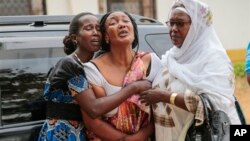A new U.N. report gives a bleak forecast through October for the Horn of Africa and the Great Lakes Region. It warns of more intense and widespread violence, greater population displacement and economic shocks.
OCHA -- the U.N. Office for the Coordination of Humanitarian Affairs – said the Horn of Africa and the Great Lakes Region are home to some of the world’s most vulnerable people. That’s despite economic growth and progress in achieving the Millennium Development Goals.
The report stated that “there has been a step change in the regions’ threat level in 2015.”
Pete Manfield, head of OCHA’s Regional Office for Eastern Africa, said, “If we look at what the dominating humanitarian characteristics were for Eastern Africa nine months ago, you could summarize it as a persistent, high-chronic food and nutrition crisis or emergency in pockets across the region – with a slow burn refugee crisis mostly dominated from South Sudan.”
Things have worsened since then.
“We’ve seen Burundi, the political crisis in Burundi, which is increasingly having regional impacts. Not just in terms of refugee outflows, but actually starting to threaten stability in the wider region. We’ve seen the economy in South Sudan reach crisis point, both in terms of oil revenues and its ability to pay civil servants. And of course we’ve seen Yemen get substantially worse and we’re on the verge of that becoming a global crisis,” he said.
The Humanitarian Scenario said the situation in Burundi “will most likely remain restive for the foreseeable future.” Well over 140,000 people have fled the country since early April after President Pierre Nkurunziza declared he would seek a third term.
Yemen is included with the African hotspots because thousands are fleeing fighting there and going to Djibouti and Somalia. Those countries have their own migrant, refugee and food security problems. Those fleeing Yemen are not only citizens, but African migrants and refugees now forced to return to the continent.
“Now these three crises coupled with the protracted situation in food and nutrition are presenting a new threat. And we think that a line has basically been passed in the sand in terms of threat level. This is having compounding impacts on states – not just those in conflict – but those that are neighboring to conflict centers,” said Manfield.
He said these crises coincide with a record level of global humanitarian needs.
“Our concern is that the region will be overlooked both politically and financially. And we need obviously adequate finance to respond. And we need the right level of political engagement to solve crises at their source. And that’s never been more needed now [than] in Burundi and South Sudan and Yemen in order to stop this deteriorating further.”
Crises in Africa, Asia and the Middle East have a common by-product – thousands of migrants and refugees fleeing to Europe.
Unresolved conflict and violence in Somalia and the Eastern DRC are having detrimental effects on neighboring countries. These include attacks by the Somali militant group al-Shabab in Kenya – and the flood of refugees from Congo.
Meeting all the humanitarian needs takes money and there’s stiff competition for it.
Manfield said, “Overall, aggregate humanitarian funding levels globally have never been higher. The problem is that the humanitarian requirements are also at a historic high. So the requirements globally for humanitarian assistance, if you add up all of the U.N. appeals, are just over $20 billion. That is an unprecedented level of requirements. And what we found is that the overall level of contributions as they stand at the end of last year was about eight and a half / nine billion. What we don’t see is donors finding more resources to fund commensurate at the same level.”
Manfield said, as a result, when funding decisions are made Syria, Nepal and South Sudan may get the bulk of the money. Less funding would be available for new crises, like Burundi.
“Burundi is having a very difficult time attracting funding because it’s having to compete with other crises globally and the region, which are sucking vast amounts of money.”
He said that Syria accounts for about 30 percent of the entire global aid requirement for 2015. The OCHA official says that humanitarian responses alone cannot solve these crises, adding political solutions can. He warns there will be “massive humanitarian consequences if that does not happen.”
















